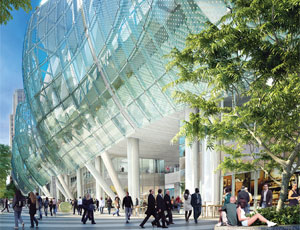Unveiled on April 22, the final design for the $1.5-billion Transbay Transit Center in San Francisco will feature high-level seismic and environmental elements. The five-story glass-and-steel station, billed as the Grand Central Station of the West, will consolidate 12 transit operations, including anticipated high-speed rail.

The Transbay Joint Powers Authority hub, designed by New Haven, Conn.-based Pelli Clarke Pelli Architects, includes a place-marker for an iconic 120-ft-tall tower that is still being negotiated financially and at City Hall for rezoning issues. Hosting Bay Area Rapid Transit, Caltrain, Greyhound bus services, Amtrak and high-speed rail, the hub will replace a smaller, concrete terminal built in 1939. The hub is part of an overall $4-billion mixed-use development project.
Thanks to a $400-million American Recovery and Reinvestment Act grant, the first phase will include construction of an underground box for the train station hub.
The building’s roof will include a 5.4-acre public park and amphitheater, which will add some 35,000 tons, requiring a robust design, says Bruce Gibbons, senior principal in the Los Angeles office of Thornton Tomasetti, the project’s structural engineer.
The building is designed to meet Leadership in Energy and Environmenal Design Gold-certified standards, with a geothermal and graywater recycling system. Plans also include features to withstand a major earthquake.
The building is essentially a 1,400-ft tube with moment frames every 42½ ft to create redundancy; the tube is broken into three structures, with 24-in. modular expansion joints supported by a 5-ft-thick concrete mat. Glass panels will be held in place by open joints at the corners, separated by 4 in. of air to prevent contact during a quake, Gibbons says.
A joint venture of San Mateo-based Webcor Builders and Japanese firm Oba-yashi Corp. won the construction contract in 2009 and will begin demolishing the existing terminal in August. Construction could be complete by 2017.
A temporary terminal under construction since December 2008 will serve current operators during the demolition phase.


Post a comment to this article
Report Abusive Comment